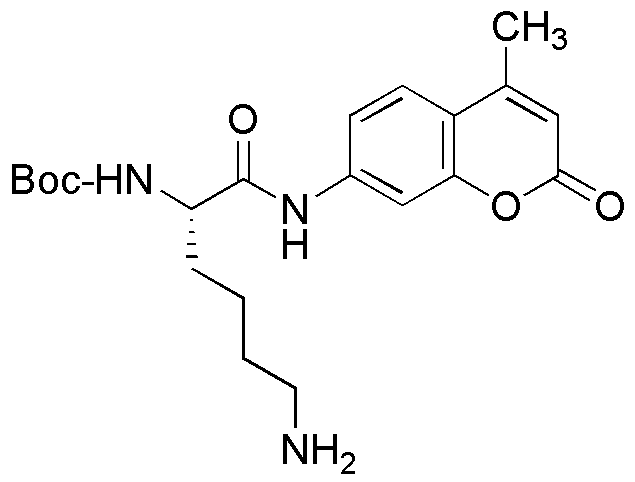Na-Boc-L-lysine 7-amido-4-methylcoumarin acetate salt is widely utilized in research focused on:
- Peptide Synthesis: This compound serves as a valuable building block in the synthesis of peptides, particularly in the development of therapeutic proteins and vaccines.
- Fluorescent Probes: Its unique structure allows it to function as a fluorescent probe, aiding in cellular imaging and tracking biological processes in real-time.
- Drug Development: The compound is used in the design of novel drug candidates, especially in targeting specific biological pathways, enhancing efficacy and reducing side effects.
- Bioconjugation: It facilitates bioconjugation techniques, enabling the attachment of biomolecules to surfaces or other molecules, which is crucial in diagnostics and therapeutic applications.
- Research in Enzyme Activity: This chemical is instrumental in studying enzyme kinetics and mechanisms, providing insights into enzyme functions and potential inhibitors.
General Information
Properties
Safety and Regulations
Applications
Na-Boc-L-lysine 7-amido-4-methylcoumarin acetate salt is widely utilized in research focused on:
- Peptide Synthesis: This compound serves as a valuable building block in the synthesis of peptides, particularly in the development of therapeutic proteins and vaccines.
- Fluorescent Probes: Its unique structure allows it to function as a fluorescent probe, aiding in cellular imaging and tracking biological processes in real-time.
- Drug Development: The compound is used in the design of novel drug candidates, especially in targeting specific biological pathways, enhancing efficacy and reducing side effects.
- Bioconjugation: It facilitates bioconjugation techniques, enabling the attachment of biomolecules to surfaces or other molecules, which is crucial in diagnostics and therapeutic applications.
- Research in Enzyme Activity: This chemical is instrumental in studying enzyme kinetics and mechanisms, providing insights into enzyme functions and potential inhibitors.
Documents
Safety Data Sheets (SDS)
The SDS provides comprehensive safety information on handling, storage, and disposal of the product.
Product Specification (PS)
The PS provides a comprehensive breakdown of the product’s properties, including chemical composition, physical state, purity, and storage requirements. It also details acceptable quality ranges and the product's intended applications.
Certificates of Analysis (COA)
Search for Certificates of Analysis (COA) by entering the products Lot Number. Lot and Batch Numbers can be found on a product’s label following the words ‘Lot’ or ‘Batch’.
Numéro de catalogue
Numéro de lot/série
Certificates Of Origin (COO)
This COO confirms the country where the product was manufactured, and also details the materials and components used in it and whether it is derived from natural, synthetic, or other specific sources. This certificate may be required for customs, trade, and regulatory compliance.
Numéro de catalogue
Numéro de lot/série
Safety Data Sheets (SDS)
The SDS provides comprehensive safety information on handling, storage, and disposal of the product.
DownloadProduct Specification (PS)
The PS provides a comprehensive breakdown of the product’s properties, including chemical composition, physical state, purity, and storage requirements. It also details acceptable quality ranges and the product's intended applications.
DownloadCertificates of Analysis (COA)
Search for Certificates of Analysis (COA) by entering the products Lot Number. Lot and Batch Numbers can be found on a product’s label following the words ‘Lot’ or ‘Batch’.
Numéro de catalogue
Numéro de lot/série
Certificates Of Origin (COO)
This COO confirms the country where the product was manufactured, and also details the materials and components used in it and whether it is derived from natural, synthetic, or other specific sources. This certificate may be required for customs, trade, and regulatory compliance.


